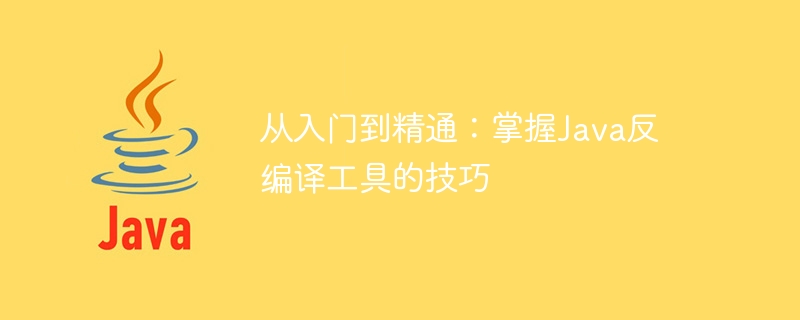Home >Java >javaTutorial >Tips for Java Decompilation Tools: An Advanced Guide from Beginner to Expert
Tips for Java Decompilation Tools: An Advanced Guide from Beginner to Expert
- WBOYWBOYWBOYWBOYWBOYWBOYWBOYWBOYWBOYWBOYWBOYWBOYWBOriginal
- 2024-01-09 19:37:281593browse

From entry to proficiency: Mastering the skills of Java decompilation tools
Introduction:
In the field of software development, the Java language has become the most popular and widely used one of the languages. When writing and debugging Java code, sometimes we need to decompile the compiled code to obtain more information. Therefore, it is very important for Java developers to master common Java decompilation tools and techniques.
1. Introduction to Java decompilation tool
Java decompilation tool is a tool that converts compiled Java code back to the original Java source code. By using decompilation tools, we can analyze the compiled code, view the algorithm logic and detailed implementation, and learn and acquire new knowledge from it.
Currently, there are many commonly used Java decompilation tools, such as:
- JAD (Java decompiler)
- JD-GUI
- CFR (Decompiler)
- Procyon
- Fernflower
- Bytecode Viewer
This article will take JD-GUI, CFR and Procyon as examples , demonstrates how to use these tools for Java decompilation.
2. Use of JD-GUI decompilation tool
JD-GUI is a powerful and easy-to-use Java decompilation tool. The following is a simple usage example of JD-GUI:
- First, we need to download the JD-GUI tool locally, install and run it.
- After opening the JD-GUI tool, click "File" -> "Open" and select the Java class file that needs to be decompiled.
- The decompilation results will be displayed in the JD-GUI interface in a form similar to Java source code.
3. Use of CFR decompilation tool
CFR is another powerful Java decompilation tool that can decompile a lot of useful information. The following is an example of using CFR:
- Similar to JD-GUI, we first need to download and install the CFR tool.
- The use of the CFR tool is relatively simple. You only need to use the command line to execute the following command:
java -jar cfr_0_151.jar /path/to/classFile.class
Among them, /path/to/classFile.class is the path of the Java class file that needs to be decompiled. - The decompilation results will be output in the command line interface in a form similar to Java source code.
4. Use of Procyon decompilation tool
Procyon is an open source Java decompilation tool that provides high-quality decompilation output. The following is an example of using Procyon:
- Similarly, we need to download and install the Procyon tool first.
- Open the command line interface and execute the following command:
java -jar procyon-decompiler.jar /path/to/classFile.class
Among them, /path/to/ classFile.class is the path to the Java class file that needs to be decompiled. - The decompilation results will be output in the command line interface in a form similar to Java source code.
Conclusion:
Through the introduction of this article, we have learned how to use the commonly used Java decompilation tools JD-GUI, CFR and Procyon. Mastering these tools and techniques not only helps us better understand and learn from other people's code, but also helps when debugging and optimizing our own code. I hope this article will be helpful to Java developers and enable them to better use decompilation tools to improve their development skills and experience.
Attachment: Download link for commonly used decompilation tools:
- JD-GUI: http://jd.benow.ca/
- CFR: https:// www.benf.org/other/cfr/
- Procyon: https://bitbucket.org/mstrobel/procyon/wiki/Java Decompiler
The above is the detailed content of Tips for Java Decompilation Tools: An Advanced Guide from Beginner to Expert. For more information, please follow other related articles on the PHP Chinese website!

